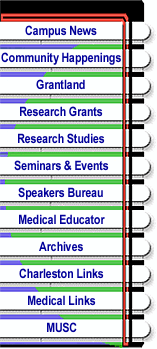


|
Document Imaging System put to good useby Tamara PomerantzCenter for Computers and Information Technology The medical record has taken on a new meaning for the Hollings Cancer Center and Hematology/Oncology staff and physicians. In June, OmniVision, the Document Imaging System application from LanVision, was rolled out to the Hollings and Hem/Onc pilot areas. The Document Imaging System, a component of MUSC's electronic medical record project, EMERALD, has been several years in the making. The Document Imaging System bridges the gap between paper and direct electronic entry of patient information in the medical record. Last October, the Health Information Services (HIS) Imaging staff began scanning paper charts. Once a page in a chart is scanned, it is stored as an electronic image viewable by an application called OmniVision. Traditionally, when a clinician requires a chart, it is necessary to call the medical records department, request the chart and wait for its delivery, assuming that the chart can be located or isn't already checked out. Once the chart is received, the clinician must leaf through the paper forms searching for the document needed to answer a question or provide patient care. The Document Imaging System eliminates these obstacles by providing instant simultaneous access for all appropriate care providers who require information concerning a patient. Further, the Document Imaging System structures the patient chart in a logical, ordered manner, using categories and encounter dates that allow for easy retrieval of pertinent information. The Document Imaging pilot areas have been using OmniVision to view their scanned charts and provide feedback on how the system works in the patient care arena. During its development, the Medical Records Committee and pilot representatives worked diligently with the HIS imaging team to identify new procedures and policies and to provide input on how the Document Imaging System should be structured. Pilot representatives include clinical coordinators Kathi Callahan and Peggy Anthony, business operations coordinator Audrey Smith, and registered nurse Laura Milligan. Procedures continue to be improved upon, and regular usage continues to grow as everyone learns and gains from this experience. Lawrence Afrin, M.D., Hematology and Oncology physician, commented, “In these last two weeks while I've been on ward service on 8West, I've seen nurses, residents, and fellows making extensive use of the system. Several of them have commented to me how useful it is, and one nurse exclaimed, ‘I love that system!’” Linda Monroe, a nurse in Hollings Cancer Center provides another account
of how the system can assist in patient care. Monroe needed to review prescriptions
written for a patient and found that the paper chart was not available.
The information needed could be reviewed, however, by accessing the scanned
chart through OmniVision.
|